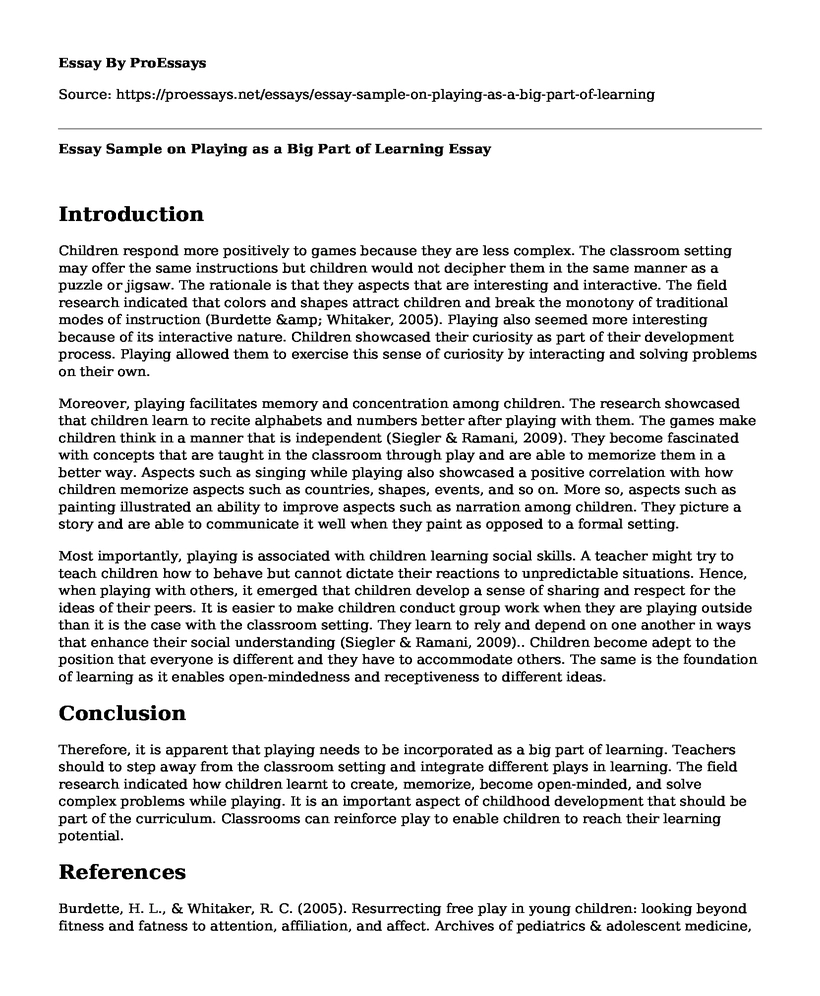Introduction
Children respond more positively to games because they are less complex. The classroom setting may offer the same instructions but children would not decipher them in the same manner as a puzzle or jigsaw. The rationale is that they aspects that are interesting and interactive. The field research indicated that colors and shapes attract children and break the monotony of traditional modes of instruction (Burdette & Whitaker, 2005). Playing also seemed more interesting because of its interactive nature. Children showcased their curiosity as part of their development process. Playing allowed them to exercise this sense of curiosity by interacting and solving problems on their own.
Moreover, playing facilitates memory and concentration among children. The research showcased that children learn to recite alphabets and numbers better after playing with them. The games make children think in a manner that is independent (Siegler & Ramani, 2009). They become fascinated with concepts that are taught in the classroom through play and are able to memorize them in a better way. Aspects such as singing while playing also showcased a positive correlation with how children memorize aspects such as countries, shapes, events, and so on. More so, aspects such as painting illustrated an ability to improve aspects such as narration among children. They picture a story and are able to communicate it well when they paint as opposed to a formal setting.
Most importantly, playing is associated with children learning social skills. A teacher might try to teach children how to behave but cannot dictate their reactions to unpredictable situations. Hence, when playing with others, it emerged that children develop a sense of sharing and respect for the ideas of their peers. It is easier to make children conduct group work when they are playing outside than it is the case with the classroom setting. They learn to rely and depend on one another in ways that enhance their social understanding (Siegler & Ramani, 2009).. Children become adept to the position that everyone is different and they have to accommodate others. The same is the foundation of learning as it enables open-mindedness and receptiveness to different ideas.
Conclusion
Therefore, it is apparent that playing needs to be incorporated as a big part of learning. Teachers should to step away from the classroom setting and integrate different plays in learning. The field research indicated how children learnt to create, memorize, become open-minded, and solve complex problems while playing. It is an important aspect of childhood development that should be part of the curriculum. Classrooms can reinforce play to enable children to reach their learning potential.
References
Burdette, H. L., & Whitaker, R. C. (2005). Resurrecting free play in young children: looking beyond fitness and fatness to attention, affiliation, and affect. Archives of pediatrics & adolescent medicine, 159(1), 46-50.
Siegler, R. S., & Ramani, G. B. (2009). Playing linear number board games-but not circular ones-improves low-income preschoolers' numerical understanding. Journal of educational psychology, 101(3), 545.
Cite this page
Essay Sample on Playing as a Big Part of Learning. (2022, Apr 14). Retrieved from https://proessays.net/essays/essay-sample-on-playing-as-a-big-part-of-learning
If you are the original author of this essay and no longer wish to have it published on the ProEssays website, please click below to request its removal:
- Paper Example on Best Practice in NAEYC Program Standards
- Online Classroom Is Better Than Traditional Classroom Essay
- Critical Thinking: Racial Segregation
- Gender Inequality: Critical Thinking Assignment
- A Touching Tale: How I Found My Calling in Medicine - Essay Sample
- Essay Example on Houston ISD: A Leader in US Education Excellence
- Agape and Philautia: Symbiosis or Parasitism?







